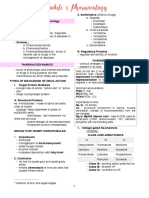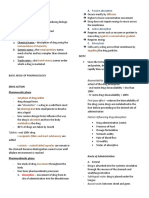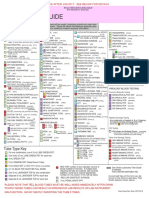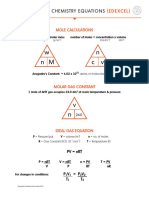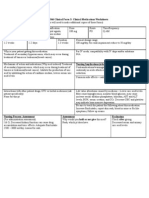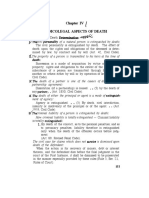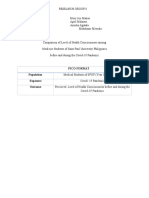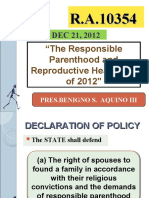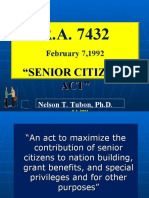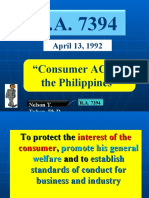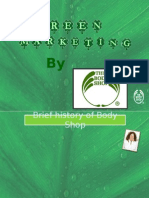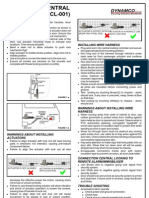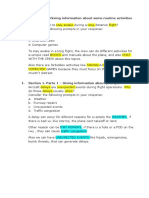0 ratings0% found this document useful (0 votes)
153 viewsMod 5 - Phardose PDF
Mod 5 - Phardose PDF
Uploaded by
Donzzkie DonCopyright:
© All Rights Reserved
Available Formats
Download as PDF, TXT or read online from Scribd
Mod 5 - Phardose PDF
Mod 5 - Phardose PDF
Uploaded by
Donzzkie Don0 ratings0% found this document useful (0 votes)
153 views7 pagesOriginal Title
MOD 5 - PHARDOSE.pdf
Copyright
© © All Rights Reserved
Available Formats
PDF, TXT or read online from Scribd
Share this document
Did you find this document useful?
Is this content inappropriate?
Copyright:
© All Rights Reserved
Available Formats
Download as PDF, TXT or read online from Scribd
Download as pdf or txt
0 ratings0% found this document useful (0 votes)
153 views7 pagesMod 5 - Phardose PDF
Mod 5 - Phardose PDF
Uploaded by
Donzzkie DonCopyright:
© All Rights Reserved
Available Formats
Download as PDF, TXT or read online from Scribd
Download as pdf or txt
You are on page 1of 7
PHARMACEUTICAL DOSAGE FORMS
-----------------------------------------------------------------
I. INTRODUCTION o Pulverization by Intervention – addition of volatile
substance to gummy materials (ex. camphor + alcohol; I2
Dosage Forms – drug products/preparations containing:
crystals + ether)
o Active Pharmaceutical Ingredient (API)/ Drug
Mixing/Blending
o Exipients/Additives/Adjuncts
o Trituration – mortar and pestle
Drug – any article intended for use in diagnosis, cure,
Types of mortar and pestle
treatment, mitigation or prophylaxis in man and other animals
Glass – smooth non-porous surface; for simple
– affects the structure or any function of the body
admixture; for chemicals that stain
Excipients – inactive ingredients
Porcelain – rough inner surface; for comminction
o Role: drugs more appealing and efficacious
Wedgewood – rougher surface; for crystalline
o Use: solubilize, suspend, emulsify, dilute, stabilize,
substances
preservatives, color, flavor, etc.
o Spatulation – use of spatula; not for potent substances
Placebo – dosage form that does not contain an API
o Sifting – use of sifter; not for potent substances
Drug Delivery System – products that allow for uniform
o Geometric Dilution – addition of an equal volume of diluent
release and targeting of drugs into body
to a potent substance placed in a mortar
Cosmetics – any substance/preparation intended to be placed
o Tumbling – large containers rotated by a motorized process
in contact with external parts of human body or with teeth and
TYPES OF POWDER
mucous membranes of oral cavity with a view exclusively or
o Bulk Powders – dispensed in large quantities
mainly to cleaning them, perfuming them, correcting body
Oral Powders – dissolved/dispersed in a liquid or mixed
odors, changing their appearance, protecting them and/or
with food before use
keeping them in good condition
Dentrifices – contain a soap, mild abrasive and
Compounding – preparation, mixing, packaging or labeling of anticariogenic agent
a drug to prepare an individualized drug treatment for a Dusting Powders – locally applied non-toxic powders that
patient
have no systemic action
REASONS FOR FORMULATING DOSAGE FORMS: appearance, Douche Powders – dissolve in warm water prior to use as
palatability, ease of administration, solubility, stability cleansing agent/antiseptic for a body cavity
Insufflators – blown into body cavities using an insufflator
II. SOLID DOSAGE FORMS Triturations – dilutions of potent powdered drugs (10%
A. POWDERS API)
o Divided Powders/Chartulae – dispersed in individual doses
intimate mixtures of finely divided drugs or chemicals in dry
usually in folded papers
form which may be used internally or externally
TYPES OF POWDER PAPER
size: sieve no.
o White Bond Paper – opaque paper with no moisture
o very coarse – no. 8
resistance
o coarse – no. 20
o Glassine Paper – glazed transparent moisture-resistant
o moderately coarse – no. 40
paper
o fine – no. 60
o Vegetable Parchment – thin, semi-opaque, moisture-
o very fine – no. 80
resistant paper
Advantages: rapid dispersion of ingredients; flexibility in
o Waxed Paper – transparent waterproof paper; suitable for
compounding; good stability
deliquescent and hygroscopic drugs
Disadvantages: inaccuracy of dose; not suitable for dispersing
deliquescent and hygroscopic drugs
COMPOUNDING:
o Trituration – mortar and pestle
o Levigation – forming a paste by addition of levigating agent
(ex. mineral oil, glycerin)
PAGE 1 OF 7 © MANOR REVIEW CENTER NOTES (K.L)
B. GRANULES Sublingual Tablets – dissolve rapidly under tongue for
systemic absorption (ex. Nitroglycerin, ISDN)
prepared agglomerates of powders; size: sieve no. 4 to 12; for
Lozenges – candies that dissolve slowly in mouth for local
tablet formulation: sieve no. 12 to 20
effect (ex. Strepsils® - dicholorobenzyl alcohol +
Advantages: flow well compared to powders; less tendency to
amylmetacresol)
cake or harden; more stable to humidity; more easily wetted
TYPES:
by liquids
Troches – compressed lozenges
PREPARATIONS:
Pastilles – molded lozenges
o Wet Granulation – most common; addition of liquid binder
Lollipops – lozenges on sticks
o Dry Granulation – for moisture-sensitive and heat labile
o Tablets Used to Prepare Solutions
materials; use compaction/compression forces
Effervescent Tablets – ex. Alka-Setlzer® - antacid + pain
o Effervescent Granules – dissolved in water before use in
reliever
which CO2 gas is released to mask the unpleasant taste of
Compounding/Dispensing Tablets – contain a large
drug
amount of API used by pharmacists in compounding
COMPONENTS:
multiple dosage units
o NaHCO3
Hypodermic Tablets – used by physicians to prepare
o Citric acid sticky
parenteral solutions
o Tartaric acid crumble
Molded Tablets/Tablet Triturates
PREPARATION:
o Dry/Fusion Method – binder is 1 molecule of water in citric
acid D. CAPSULES
o Wet Method – binder is water + alcohol solid dosage forms in which drug is endosed within either a
hard or soft soluble shell usually made of gelatin
C. TABLETS o Gelatin – partial hydrolysis of collagen from the skin/bones
solid dosage forms which are prepared mainly by compression of animals
or molding Types:
Advantages: precision and low content variability; low Type A – acid hydrolysis
manufacturing cost; easy to package and ship; simple to Type B – base hydrolysis
identify; most stable of all oral dosage form; tamper proof Alternative: hydroxypropyl methylcellulose (HPMC) or
Disadvantages: some drugs resist compression; some drugs stach
that require encapsulation prior to compression Types of Capsules:
TYPES OF TABLETS: Hard Gelatin Capsules – dry-filled or two-piece capsules (cap
o Tablets for Oral Ingestion and body)
Compressed Tablets – formed by compression; some are o made of gelatin, sugar and water + colorant + opacifying
scored agent (TiO2) + SO2 [0.15%] (to prevent decomposition of gel)
Multiple Compressed Tablets – ex. layered tablets, o contains 12-16% moisture
compression coated tablets o stored at 21-25oC/30-35% RH
Coated Tablets o capsule sizes: (increase capsule size = decrease capacity)
Sugar Coated Tablets – coated with a water soluble Human – No. 5 (smallest) – No. 000 (largest)
sucrose-based solution Veterinary – No 10. – No. 12
Film Coated Tablets – coated with a thin layer of Soft Gelatin Capsules – one-piece capsules; contains non-
polymer material aqueous liquids (vitamin e, cod liver oil, digoxin), suspensions,
Enteric-Coated Tablets – remain intact in stomach and pastes, and dry solids
disintegrate in small intestine o made of gelatin, plasticizer (glycerin, sorbitol) and
o Tablets Used in the Oral Cavity preservatives against fungi
Chewable Tablets – chewed in mouth before swallowing; o contains 6-10% moisture
does not contain disintegrant; diluent: mannitol and o no specific sizes
xylitol
Rapidly/Orally Disintegrating Tablets – liquefy on tongue
before swallowing (ex. Resperidone, Ondasetron)
Buccal Tablets – dissolve slowly in cheeks/buccal pouch
for systemic absorption (ex. Progesterone)
PAGE 2 OF 7 © MANOR REVIEW CENTER NOTES (K.L)
E. ORAL MODIFIED-RELEASE SOLID DOSAGE polymorphism (ȣ - least stable [18oC]; α; β’; β – most
stable [34.5oC]
FORMS Wecobee ® - from coconut
drug release features are based on time, course and locations Witepsol ® - saturated PAs (C12-C18); major: lauric acid
Reasons: Glyceryl Monopalmitate
o to prolong therapeutic effect to reduce dosing frequency Water-Soluble/Miscible Base
o to delay the effect Glycerinated Gelatin – most common base for pessaries
Polyethylene Glycol (PEG)
o PREPARATIONS:
MTC Hand Molding/Rolling/Shaping – oldest and simplest;
base is rolled into desired shape by hand
Cp Compression Molding – base is forced into molds;
problem: air entrapment
MEC Pour/Melt Molding – most common; base melted and
poured into molds
immediate
controlled Vaginal Tablets/Inserts – ovoid tablets inserted into the
sustained
delayed vagina using a plastic inserter; contains antimicrobial agents
Implants/Pellets – small, sterile cylinders or devices inserted
under the skin for prolonged and continuous absorption
Time
o Norplant ® - levonorgestel (5 years)
onset onset o Leuprolide – prostate cancer (1 year)
Types:
o Extended-Release – provides a prompt-desired effect III. SEMI-SOLID DOSAGE FORMS3
followed by a gradual release of remaining amount
Problem: dose dumping
A. OINTMENTS
Types: semi-solid dosage forms applied externally on the skin or the
Controlled Release – zero order mucous membranes
Sustained Release – first order Types:
o Delayed-Release – drug release is other than the time of o Medicated – contains activated pharmaceutical ingredients
prompt administration (API)
o Repeat Actions – contains 2 single doses of a medication (1st o Non-Medicated – used as base
dose immediate; 2nd dose delayed) Ointment Bases:
o Targeted Release – drug release is isolated in a specific body o Oleaginous/Hydrocarbon Base – greasy, anhydrous,
region/tissue absorption and action emollient, occlusive, non-water washable
Petrolatum/Yellow Petrolatum/Petroleum Jelly
(Vaseline®) – purified mixture of semisolid hydrocarbon
D. PHARMACEUTICAL INSERTS from petroleum
Suppositories – solid masses inserted into body cavities in White Petrolatum – decolorized
which they will melt at body temperature or dissolve into Yellow Wax/Beeswax – wax obtained from the
aqueous secretions of body orfice honeycomb of Apis mellifera
o Types: Rectal; Vaginal (Pessaries); Urethral (Bougies) – ex. White Wax – bleached
Alprostadil (for erectile dysfunction) Yellow/Simple Ointment – yellow petrolatum + yellow
FEATURES RECTAL VAGINAL URETHRAL
wax
SHAPE Bullet Globular Pencil-like
Torpedo Ovoid White Ointment – white petrolatum + white wax
Cone o Absorption Base – greasy, emollient, occlusive, non-water
WEIGHT Adult: 2g 5g Male: 4g
washable; can absorb small amounts of water w/o
Pedia: 1g Female: 2g
SIZE Adult: 32mm Varies Male: 140mm Hydrophilic Petrolatum (Aquaphor®) – petrolatum +
Pedia: 16mm Female: 70mm cholesterol (emulsifying agent) + beeswax + stearyl
INTENDED USE Both Local Local
alcohol
o SUPPOSITORY BASES
Anhydrous Lanolin/Woolfat – wax-like substance from
Oleaginous Base the wool of Ovis aries (sheep) containing 0.25% moisture
Cocoa Butter – most common base for rectal *Hydrous Lanolin – 25% moisture; Modified Lanolin –
suppository; solid at 32oC, melts at 34-35oC; exhibits without free lanolin alcohols and excess detergents
PAGE 3 OF 7 © MANOR REVIEW CENTER NOTES (K.L)
o Water-Removable Base – o/w; water-washable; non- IV. TRANSDERMAL DRUG DELIVERY SYSTEM
occlusive; non-greasy; can be diluted with large amounts of
controlled release DDS or patches which allow the passage of
water
drugs from the skin to the systemic circulation
Hydrophilic Ointment
PARTS OF TDDS:
o Water-Soluble Base – lipid-free; greaseless; water-
o Occlusive Backing Layer – prevents water loss and drug loss
washable; non-occlusive; for incorporation of solid materials
o Drug Matrix System – stores API
Polyethylene Glycol (PEG) Ointment – MW < 600
o Adhesive Layer – ensures continuous drug absorption
liquids; MW > 100 wax-like solids; MW 600-1000
o Release Liner – removed before use to enable drug release
semisolids
EXAMPLES:
o Scopolamine (Transderm Sccp®) – 1st TDDS developed; for
B. CREAMS motion sickness
semi-solid preparations containing APIs dissolved or dispersed o Nitroglycerin – angina
in w/o or o/w emulsion or water-washable base; preferred: o Clonidine – 1st TDDS for hypertension
ease of spreadability o Fentanyl – opioid analgesic
o Vanishing Creams – o/w base; large % water – ex. glycerin, o Estradiol and Testosterone – hormone replacement therapy
propylene glycol – + stearic acid
o Cold Cream/Petrolatum Rose Water Ointment – w/o base; V. LIQUID DOSAGE FORMS SINGLE PHASE
mineral oil less rancid; white wax; spermaceti (cetyl
Solutions – liquid preparations containing one or more
esters wax) + Na borate
substances dissolved in a suitable solvent
Advantages: completely homogenous dose; immediate
C. GELS availability for absorption; flexible
dispersion systems consisting of small inorganic particles or Disadvantages: degrade more rapidly; interact with other
large organic molecules dispersed throughout a liquid vehicle, component; bulky
rendered jelly-like by addition of a gelling agent; thixotropy – DESCRIPTIVE TERMS PARTS OF SOLVENT REQUIRED FOR
reversible gel-sol formation 1 PART OF SOLUTE
Very Soluble <1
Freely Soluble 1-10
D. PASTES Soluble 10-30
semi-solid preparations applied on skin and contain a large Sparingly Soluble 30-100
proportion of solid material (≥25%) and therefore stiffer than Slightly Soluble 100-1,000
ointments Very Slightly Soluble 1,000-10,000
Insoluble >10,000
Use: to prolong contact of drug
Water Official Types:
Zinc Oxide Paste (ZnO) – treatment of diaper rash
o Purified Water – distillation; reverse osmosis; ion exchange
o Water for Injection – purified water that is pyrogen-free
E. PLASTERS o Sterile Water for Injection – water for injection that is
solid or semisolid adhesive masses spread on a backing of sterilized
paper, fabric, moleskin or plastic o Bacteriostatic Water for Injection – sterile water for
Use: to prolong the contact of drug and affords protection injection with antimicrobial agent (benzyl alcohol); not for
Salicylic Acid Plaster – keratolytic (10-40% salicylic acid) neonates
o Sterile Water for Inhalation
F. GLYCEROGELATIN o Sterile Water for Irrigation
plastic masses applied on skin with a fine brush
contains: 40% glycerin, 35% water, 15% gelatin, 10% AI A. AQUEOUS SOLUTIONS
Zinc Gelatin Boot – treatment of varicose ulcers Aromatic Water/Medicated Waters – clear, saturated
aqueous solutions of volatile oils or other aromatic substances;
o Use: flavored/perfumed vehicles
G. POULTICES/CATAPLASM
o Preparations:
soft, moist masses of meal, herbs, seeds, etc.; applied hot in a
Distillation – not economical; only method for: Strong
cloth
Rose Water, Orange Flower Water
Use: to localize infectious materials and counterirritant
Simple Solution – with or without dispersant (ex. talc)
Kaolin Poultice – treatment for boils and anti-inflammatory o Problem: Salting out – insoluble layer at top
PAGE 4 OF 7 © MANOR REVIEW CENTER NOTES (K.L)
Diluted Acids – aqueous solutions prepared by dissolving Solution without Heat – prevents sucrose inversion
concentrated acids in water; strength: 10% w/v; (ex. Diluted Percolation – slow rate (1mL/min); to prevent bubbles
HCl – treatment for achlorhydria; taken with straw) (oxidation)
Astringent – locally applied solutions that precipitate proteins Reconstitution – addition of sugar to a medicated liquid;
and cause constriction of the skin addition of medicated liquid to syrup
o Aluminum Acetate Topical Solution – wet dressing in Honeys – somewhat allied to syrups but using honey as base
contact dermatitis Mucilages – thick, viscid, adhesive liquids
o Calcium Hydroxide Topical Solution – more soluble in cold o PREPARATIONS:
water Dispersion of gums in water
o Coal Tar Topical Solution – for eczema Extraction of mucilaginous principles
Antibacterial Topical Solutions o Use: suspending agent
o Hydrogen Peroxide Topical Solution o ex.: Acacia Mucilage, Tragacanth Mucilage
2H2O2 –(catalase)--> O2^ + 2H2O (3% = 10 volumes – Jellies – class of gels in which structural coherent matrix
antiseptic); (6% = 20 volumes – bleaching agent) contains a high portion of water; use: lubricant, contraceptive,
o Povidone-Iodine Topical Solution (Betadine®) – complex of topical anesthetic (Lidocaine Jelly)
10% I2 and polyvinyl pynolidone (PVP)
o Thiomersal Topical Solution (Merthiolate®) – contains 0.1% C. HYDROALCOHOLIC SOLUTIONS
thimerosal – organic, mercurial antibacterial
Elixirs – clear; sweetened hydroalcoholic solutions intended
Douche – aqueous solutions used as cleansing agent or
for oral use; alcohol: 5-40%; self-preserving at ≥10% alcohol
antiseptic for a body cavity
o PREPARATIONS:
o Eye Douche – removes foreign particles and discharges
Simple Solution
o Pharyngeal Douche – throat
Admixture of 2 Medicated Liquids
o Vaginal Douche – maintain the acidic pH of the vagina (ex.
o Types:
pH Care® - chlorhexidine gluconate)
Medicated Elixir – digoxin, phenobarbital,
Enemas – rectal solutions employed mainly to evacuate the diphenhydramine, dexamethasone
bowel (evacuation enema) or to affect a local or systemic Non-Medicate Elixir – aromatic elixirs, iso-alcoholic elixir
disease by absorption (retention enema) – better solvent; higher content
o Fleet® Enema – sodium phosphates enema; evacuation
Tinctures – hydroalcoholic solutions prepared from vegetable
enema
drugs or chemical substances; alcohol content varies; strength:
o Sulfasalazine Enema – ulcerative colitis; retention enema
10% w/v
Gargles – used for treating pharynx and nasopharynx by o PREPARATIONS:
forcing from lungs through solution held in throat Process P – percolation (ex. Belladonna Tincture)
Mouthwashes – used by swishing the liquid in oral cavity to Process M – maceration (ex. Sweet Orange Peel Tincture)
cleanse mouth or treat diseases of oral cavity Simple Solution – Iodine Tincture (2% in 50% alcohol);
Green Soap Tincture; Compound Benzoin Tincture
B. SWEET AND OTHER VISCID AQUEOUS o Opium Tincture – Laudanum
SOLUTIONS o Camphorated Opium Tincture – Paregoric
Spirits/Essences – hydroalcoholic solutions of volatile oil;
Syrups – concentrated solutions of sucrose or other sugars in
alcohol content: 50-90%
water
o PREPARATIONS:
o Types:
Simple Solution – aromatic ammonia spirit
Simple Syrup/Syrup NF – 85% w/v or 65% w/w; sp. gr. =
Solution with Maceration – peppermint spirit
1.313; self-preserving at ≥65% sugar; poor solvent for
Chemical Reaction – ethyl nitrite spirit
drugs
Distillation – brandy (spiritus vini vitis); whisky (spiritus
Flavored Syrups
frumenti)
Orange and Cherry – acidic medium
Fluidextracts – “100% Tinctures” too potent and too bitter;
Cocoa – bitter
hydroalcoholic solutions from vegetable drugs (ONLY)
Raspberry – sour and salty
prepared by percolation
Ora-Sweet® - for compounding
o PREPARATIONS:
Medicated Syrup – simple/flavored syrups + APIs
Process A – must be assayed; percolation
o PREPARATIONS:
Process E – alternative to process E; percolation (shorter
Solution w/ Heat – fastest methods; problem:
diameter and longer in length)
overheating sucrose inversion/caramelization
Process D – boiling water
PAGE 5 OF 7 © MANOR REVIEW CENTER NOTES (K.L)
o Cascara Sagrada Fluidextract – cathartic Lotions – liquid suspensions applied externally on body
o Calamine Lotion – antipruritic; ZnO + ferric oxide; trituration
D. NON-AQUEOUS SOLUTIONS o White Lotion – chemical reaction; ZnSO4 + sulfurated potash
Liniments/Embrocations – alcoholic or oleaginous solutions Mixtures – liquid preparations containing more than one
containing more than one API and are usually rubbed on the active ingredient dissolved or dispersed in al liquid vehicle
skin o Bordeaux Mixture – CuSO4 + CaO; algaecide in pools
Types: o Kaopectate – Kaolin + Pectin; antidiarrheal
o Alcoholic – penetrating action; rubefacient and
counterirritant B. EMULSIONS
o Oleaginous – massage; less irritating two-phase systems prepared by combining 2 immiscible
Collodions – clear liquids prepared by dissolving 4% pyroxylin liquids; internal/discontinuous/dispersed phase;
(cotton [cellulose tetranitrate; soluble guncotton, collodion external/continuous/dispersion medium
cotton, nitrocellulose] +HNO3 + H2SO4) in 3:1 ether and Types:
alcohol; use: water repellent protective o Oil in water (o/w)
Types: o Water in oil (w/o)
o Flexible Collodion – +3% castor oil flexible; +2% camphor o Multiple Emulsion – w/o/w or o/w/o
waterproof o Microemulsion – transparent; most stable
o Salicylic Acid Collodion – keratolytic Emulsifying Agent – reduce the interfacial tension by forming
Extracts a film at interface
o METHODS OF EXTRACTION: HLB System – increase in HLB value = increase in hypophillic
Maceration – soaking ACTIVITY HLB VALUE
Digestion – maceration with gentle heat Antifoaming 1-3
W/O Emulsifier 3-6
Infusion – maceration in hot or cold water Wetting Agent 7-9
Decoction – boiling in water O/W Emulsifier 8-18
Percolation – column/percolator Detergents 13-16
Solubilizer 15-20
o TYPES:
Semi-Liquid Extract – liquid/syrupy; no solvent is removed PREPARATIONS:
Pilular/Solid Extract – plastic; nearly all solvent is o Dry Gum/Continental Method – 4(oil): 2(water): 1(gum); oil
removed + gum, then add water all at once; w/o
Powdered Extract – dry powders; all solvent is removed o Wet Gum/English Method – 4(water): 2(oil): 1(gum); water
+ gum, then add oil gradually in small portions; o/w
o Forbes Bottle Method – for volatile oils and less viscous oils;
VI. LIQUID DOSAGE FORMS: DISPERSED 3:2:1 or 2:2:1
PHASE o Nascent Soap/In Situ Soap Method – fats/fixed oils +
aqueous solution of alkali; emulsifier: salt of free fatty acid
A. SUSPENSIONS
liquid preparations consisting of solid particles (suspensoids) VII. STERILE DOSAGE FORMS
dispersed throughout a liquid vehicle A. STERILE PRODUCTS
Types: Parenterals – injectable
o Gels Ophthalmic – eyes
PHENOMENA IN GELS: Otic – not always
Imbibition – no increase in size
Inhalationals
Swelling – increase in size
Irrigation
Syneresis – gel shrinks
Dialysis
Xerogel – formed when only framework remains
Implants
o Al(OH)3 Gel – antacid; Betamethasone Gel; Tretinoin Gel
Magmas/Milk – two-phased gels in which gel mass consist of
small distinct particles and therefore whitish in color
o PREPARATIONS:
Hydration – MgO + H2O
Chemical Reaction – MgSO4 + NaOH
o Milk of Magnesia – antacid; Bentonite Magma – suspending
agent
PAGE 6 OF 7 © MANOR REVIEW CENTER NOTES (K.L)
B. PARENTERAL ROUTES VIII. AEROSOLS
Intravenous (IV) – veins; most common and important; 100% pressurized dosage forms upon actuation will deliver a fire
bioavailability; bolus or infusion mist of the product (liquid/solid drug in a gaseous medium)
Intramuscular (IM) – mild-deltoid muscle 2mL; gluteus Types:
medius – children, gluteus maximus – adults 5mL; ex. o Space Spray – airborne mist
vaccines o Surface Spray – surface
Subcutaneous (SC/SQ) – under skin (lower abdomen, upper Components:
arm, thigh); maximum volume: 1.3mL; ex. insulin o Product Concentrate – APIs, surfactant, antioxidant,
Intradermal (ID) – most superficial skin layer (anterior perfume
forearm) 0.1mL; ex. skin test o Propellant – expels product
Intraarterial Liquefied Gas – propane, butane, isobutene,
Intracardiac hydrofluorocarbons, dimethyl ether
Intraspinal Compressed Gases – CO2, N2, N2O
Intrathecal AEROSOL CONTAINER ASSEMBLY
Intraarticular o Pressurizable Container
Intrasynovial Tin-Plated Steel – most widely used
Epidural Aluminum – seamless and more inert
Glass
o Valve – regulates flow
C. OFFICIAL INJECTIONS o Actuator – pressed to activate valve assembly
Injection – solution o Stern – supports actuator and delivers product in proper
For Injection – for reconstitution form
Injectable Emulsion o Gasket – prevents leakage of contents
Injectable Suspension o Spring – retraction of actuator
For Injectable Suspension – for reconstitution o Mounting Cup – exposed to formulation and supports valve
o Housing – supports actuator, stern, and dip tube
o Dip Tube – conveys product from bottom to valve at top
D. COMPONENTS
Active Pharmaceutical Ingredient (API)
Solvent/Vehicle
o Water: WFI, SWFI, BWFI
o NaCl Injection
o Ringer’s Injection – NaCl, KCl, CaCl2 (electrolyte replenisher)
o Lactated Ringer’s Injection – NaCl, KCl, CaCl2, Na lactate –
systemical alkalizer
o Fixed Vegetable Oils – cottonseed, corn, peanut, sesame
o Alcohol, glycerin, Ethyl Oleate, Isopropyl Myristate
Buffers – maintain the required pH
Tonicity Adjusters – reduce the pain
Preservatives
Nitrogen Gas – headspace
PAGE 7 OF 7 © MANOR REVIEW CENTER NOTES (K.L)
You might also like
- 3 PSV Bahtera Hamos - 2Document2 pages3 PSV Bahtera Hamos - 2Fikri KurniaNo ratings yet
- Virtual Lab Report by Honey Noreen Belnas: The Gram Stain: Identify and DifferentiateDocument16 pagesVirtual Lab Report by Honey Noreen Belnas: The Gram Stain: Identify and DifferentiateJihil Kisha0% (1)
- CholestyramineDocument1 pageCholestyramineKatie McPeekNo ratings yet
- Module 4 - PharmacologyDocument53 pagesModule 4 - PharmacologyDonzzkie Don100% (3)
- R.A. 8344Document16 pagesR.A. 8344Donzzkie DonNo ratings yet
- R.A. 6675Document91 pagesR.A. 6675Donzzkie Don50% (2)
- Project Report On Pavement DesignDocument50 pagesProject Report On Pavement Designsagar kumar100% (1)
- Pharmacology Notes #1 DRUG ACTIONDocument4 pagesPharmacology Notes #1 DRUG ACTIONAyumi StarNo ratings yet
- Antiviral Drugs Acting Against RNA Viruses: HIV: PHRM 412Document57 pagesAntiviral Drugs Acting Against RNA Viruses: HIV: PHRM 412Apurba Sarker ApuNo ratings yet
- ATI Flash Cards 10, Medications Affecting Digestion and NutritionDocument22 pagesATI Flash Cards 10, Medications Affecting Digestion and NutritionSue PadgettNo ratings yet
- Drug StudyDocument7 pagesDrug StudyBelle AudreyNo ratings yet
- Ineffective Coping - Nursing Diagnosis & Care Plan - NurseslabsDocument13 pagesIneffective Coping - Nursing Diagnosis & Care Plan - NurseslabsLester MooreNo ratings yet
- TransesDocument5 pagesTransesTintin HonraNo ratings yet
- Pharma CompilationDocument32 pagesPharma CompilationJustin Kaye DariaNo ratings yet
- Pharmacology A ReviewDocument15 pagesPharmacology A ReviewKathrynne MendozaNo ratings yet
- تَـلخـيـص شـابـتـر ٢٠?Document17 pagesتَـلخـيـص شـابـتـر ٢٠?سلطان محمد فوزي سلمانNo ratings yet
- A Bunch of Pharm ShitDocument2 pagesA Bunch of Pharm ShitkatNo ratings yet
- Drug ExcretionDocument20 pagesDrug ExcretionRajalingam BalaNo ratings yet
- EnalaprilDocument2 pagesEnalaprilAyah PaasaNo ratings yet
- Micro Chart #3 - Italics OnlyDocument27 pagesMicro Chart #3 - Italics Onlyapi-26938624100% (1)
- OTC Pain Relievers Dosage Chart For Adults and Children 12 Years and OlderDocument2 pagesOTC Pain Relievers Dosage Chart For Adults and Children 12 Years and OlderAdocueNo ratings yet
- TubeGuide PDFDocument1 pageTubeGuide PDFalberto100% (1)
- Pharma MnemonicsDocument10 pagesPharma MnemonicsMuhammad Ali Aziz100% (4)
- Pharma NotesDocument8 pagesPharma NotesKylahNo ratings yet
- Blood Glucose Meter PDFDocument10 pagesBlood Glucose Meter PDFsneh1509No ratings yet
- Pedia StickersDocument8 pagesPedia Stickersmkct111100% (1)
- Drugs Affecting The Gastrointestinal TractDocument61 pagesDrugs Affecting The Gastrointestinal TractSameera DahamNo ratings yet
- Pharmacology in NursingDocument1 pagePharmacology in NursingJessa Mae Barquilla100% (1)
- 35 Drugs Used DyslipidemiaDocument58 pages35 Drugs Used DyslipidemiaNibshian Dela RosaNo ratings yet
- IV FluidsDocument4 pagesIV FluidsHadi AtaallaNo ratings yet
- Ncmb316 Lec FinalDocument31 pagesNcmb316 Lec FinalDE LEON, CRONICA FAY G.No ratings yet
- CHEM-Year 2 Chemistry Cheat Sheet For EDEXCELDocument12 pagesCHEM-Year 2 Chemistry Cheat Sheet For EDEXCELraiabhijith586No ratings yet
- Virginia Henderson - Nursing Need Theory Study Guide - NurseslabsDocument12 pagesVirginia Henderson - Nursing Need Theory Study Guide - NurseslabsChaeline SP100% (1)
- تَـلـخـيـص شَـابـتـر ٢٥?Document12 pagesتَـلـخـيـص شَـابـتـر ٢٥?سلطان محمد فوزي سلمانNo ratings yet
- Math RNDocument10 pagesMath RNMs. Jia Mae CasimoNo ratings yet
- Drugs SummaryDocument23 pagesDrugs Summaryapi-3832811100% (1)
- Anti Inflamatory DrugsDocument35 pagesAnti Inflamatory DrugsKartik BNo ratings yet
- Introduction Scope of PharmacologyDocument27 pagesIntroduction Scope of PharmacologyAnuj VishwakarmaNo ratings yet
- RX 1 10Document9 pagesRX 1 10Mich Tolentino0% (1)
- Safe Medicines During PregnancyDocument1 pageSafe Medicines During PregnancyTauraabNo ratings yet
- 1 Extemporaneous Compounding - HPREDocument2 pages1 Extemporaneous Compounding - HPREKianna Marie MuyotNo ratings yet
- Zyloprim Drug CardDocument1 pageZyloprim Drug CardSheri490No ratings yet
- Vital Signs by Age: Age HR SBP DBP RRDocument1 pageVital Signs by Age: Age HR SBP DBP RRJe KirsteneNo ratings yet
- 2.drugs Acting On The EyeDocument19 pages2.drugs Acting On The EyeEman MohamedNo ratings yet
- Narcotic Analgesics PDFDocument13 pagesNarcotic Analgesics PDFZehra AmirNo ratings yet
- AntidoteDocument5 pagesAntidoteMaynard ArandaNo ratings yet
- Thyroid Disease (Chan)Document29 pagesThyroid Disease (Chan)Sidiq AboobakerNo ratings yet
- Peptic Ulcer - Classification and Mechanism of ActionDocument1 pagePeptic Ulcer - Classification and Mechanism of ActionNovaNo ratings yet
- PharmacologyDocument218 pagesPharmacologydaisyNo ratings yet
- NCM 0106 - M4. Drug Nomenclature, Drug Dosage, Drug InteractionsDocument8 pagesNCM 0106 - M4. Drug Nomenclature, Drug Dosage, Drug InteractionsKristine KimNo ratings yet
- Gastro Intestinal Disorders:: Kawasaki DiseaseDocument6 pagesGastro Intestinal Disorders:: Kawasaki DiseaseJoanna TaylanNo ratings yet
- Drug PrilosecDocument1 pageDrug PrilosecSrkocher100% (1)
- Principle of Drug ActionDocument4 pagesPrinciple of Drug ActionChristopher jan Legaspi100% (1)
- HemophiliaDocument19 pagesHemophiliaAtiya HajjajNo ratings yet
- Emergency DrugsDocument9 pagesEmergency DrugsaldwinngNo ratings yet
- Review Notes For Diabetes MellitusDocument8 pagesReview Notes For Diabetes MellitusEditha LucasNo ratings yet
- Contin. Pharma NotesDocument37 pagesContin. Pharma Notesdelie joy dacdac0% (1)
- Baby Katzung Case 1 10Document15 pagesBaby Katzung Case 1 10Danielle Sabrina LimNo ratings yet
- Analgesic OintmentDocument3 pagesAnalgesic OintmentTim BorjaNo ratings yet
- Pharm Chapter 2 and 3 Study GuideDocument10 pagesPharm Chapter 2 and 3 Study GuideamkNo ratings yet
- Drug Name Mechanism of Action Dosage Indication Contraindication Side Effects/ Adverse Effects Nursing ResponsibilitiesDocument4 pagesDrug Name Mechanism of Action Dosage Indication Contraindication Side Effects/ Adverse Effects Nursing ResponsibilitiesKat BausaNo ratings yet
- The politics of hunger: Protest, poverty and policy in England, <i>c.</i> 1750–<i>c.</i> 1840From EverandThe politics of hunger: Protest, poverty and policy in England, <i>c.</i> 1750–<i>c.</i> 1840No ratings yet
- Cee 2 - DDSDocument15 pagesCee 2 - DDSKristina NizabelaNo ratings yet
- Solid Dosage Form Part 1Document48 pagesSolid Dosage Form Part 1Claire Marie AlvaranNo ratings yet
- Lesson 3.2 - Solid Dosage FormsDocument16 pagesLesson 3.2 - Solid Dosage FormsMark Harold GonzalesNo ratings yet
- DiarrheaDocument22 pagesDiarrheaDonzzkie DonNo ratings yet
- VirologyDocument31 pagesVirologyDonzzkie DonNo ratings yet
- Schwartz's Principles of Surgery ABSITE and Board Review, Ninth Edition (PDFDrive)Document517 pagesSchwartz's Principles of Surgery ABSITE and Board Review, Ninth Edition (PDFDrive)Donzzkie Don100% (1)
- Understand The ProblemDocument1 pageUnderstand The ProblemDonzzkie DonNo ratings yet
- Third Paragraph On PHYSICAL ACTIVITYDocument1 pageThird Paragraph On PHYSICAL ACTIVITYDonzzkie DonNo ratings yet
- Pattaguan, Donesthel M PDFDocument2 pagesPattaguan, Donesthel M PDFDonzzkie DonNo ratings yet
- Aspects of DeathDocument45 pagesAspects of DeathDonzzkie DonNo ratings yet
- Module 6 - Microbiology and ParasitologyDocument35 pagesModule 6 - Microbiology and ParasitologyDonzzkie DonNo ratings yet
- Chapter 6: Microbial GrowthDocument9 pagesChapter 6: Microbial GrowthDonzzkie DonNo ratings yet
- Pico Format Population Exposure OutcomeDocument4 pagesPico Format Population Exposure OutcomeDonzzkie DonNo ratings yet
- Department of BiochemistryDocument16 pagesDepartment of BiochemistryDonzzkie DonNo ratings yet
- Mod 6 - Micro To paraDocument18 pagesMod 6 - Micro To paraDonzzkie DonNo ratings yet
- R.A. 10354Document36 pagesR.A. 10354Donzzkie Don100% (6)
- A Case On Typhoid Fever: Group 4Document27 pagesA Case On Typhoid Fever: Group 4Donzzkie DonNo ratings yet
- June 6, 2008: Gloria Macapagal - ArroyoDocument39 pagesJune 6, 2008: Gloria Macapagal - ArroyoDonzzkie DonNo ratings yet
- R.A. 7581Document34 pagesR.A. 7581Donzzkie DonNo ratings yet
- February 7,1992: " Senior Citizens Act"Document98 pagesFebruary 7,1992: " Senior Citizens Act"Donzzkie DonNo ratings yet
- Rational Drug Design PDFDocument7 pagesRational Drug Design PDFDonzzkie DonNo ratings yet
- R.A. 7394Document62 pagesR.A. 7394Donzzkie DonNo ratings yet
- R.A. 10354Document36 pagesR.A. 10354Donzzkie DonNo ratings yet
- Group 3 Drug LitDocument79 pagesGroup 3 Drug LitDonzzkie DonNo ratings yet
- R.A. 9502Document39 pagesR.A. 9502Donzzkie DonNo ratings yet
- Module 5 Physical PharmacyDocument7 pagesModule 5 Physical Pharmacycrayon100% (2)
- Density, Specific Gravity, and Specific Volume PDFDocument22 pagesDensity, Specific Gravity, and Specific Volume PDFDonzzkie Don100% (2)
- Aseptic TechniquesDocument26 pagesAseptic TechniquesDonzzkie DonNo ratings yet
- Counseling Chronically Ill Adults in The HealthcarDocument19 pagesCounseling Chronically Ill Adults in The HealthcarDonzzkie DonNo ratings yet
- 1 Prescription FinalDocument62 pages1 Prescription FinalDonzzkie DonNo ratings yet
- UCM224D - Technical Data SheetDocument8 pagesUCM224D - Technical Data Sheet3efooNo ratings yet
- dr135 mk2Document60 pagesdr135 mk2zaenal abidinNo ratings yet
- Multimedia and ICTDocument23 pagesMultimedia and ICTJohn Mark Alexis Tuazon67% (3)
- NOTES 01 - Economic DevelopmentDocument2 pagesNOTES 01 - Economic DevelopmentpoloNo ratings yet
- Objective Type Question Bank (GATE and PSU)Document5 pagesObjective Type Question Bank (GATE and PSU)hytNo ratings yet
- Green Marketing by Body Shop FinalDocument24 pagesGreen Marketing by Body Shop FinalSurya Banerjee100% (2)
- MAricultura Artigo Internacional 2021Document18 pagesMAricultura Artigo Internacional 2021paula.ritterNo ratings yet
- 4CL 001 InstallationDocument2 pages4CL 001 Installationcool_sandy001No ratings yet
- West Virginia Lottery v. A-1 Amusement, Inc., No. 16-1047 (W. Va. Nov. 13, 2017)Document52 pagesWest Virginia Lottery v. A-1 Amusement, Inc., No. 16-1047 (W. Va. Nov. 13, 2017)RHTNo ratings yet
- Application of Information and Technology in Supply Chain Management of Fruits and Vegetables - A Brief OverviewDocument7 pagesApplication of Information and Technology in Supply Chain Management of Fruits and Vegetables - A Brief OverviewInternational Journal of Innovative Science and Research TechnologyNo ratings yet
- 04 Solar Power Experiment and Equations Mack Grady Sept 20 2012Document26 pages04 Solar Power Experiment and Equations Mack Grady Sept 20 2012AbdussalamElhanashiNo ratings yet
- Comparison of Calculation Result of 3 BuDocument31 pagesComparison of Calculation Result of 3 BuCbdtxd PcbtrNo ratings yet
- Aec1 Chapter 1Document4 pagesAec1 Chapter 1James Paolo RazalNo ratings yet
- Formatos 1 Al 15 Con Rpta PDFDocument210 pagesFormatos 1 Al 15 Con Rpta PDFBrian Izarnótegui AltamiranoNo ratings yet
- D17090GC31 sg2Document392 pagesD17090GC31 sg2Mahadev NaiknavreNo ratings yet
- A Study On Direct Selling Business (Amway India LTD) in Kerala: A Case Study of Calicut District of KeralaDocument8 pagesA Study On Direct Selling Business (Amway India LTD) in Kerala: A Case Study of Calicut District of Keralakiit2012-civil-212 civilNo ratings yet
- VANSHIKA Statement of Purpose Curtin UniDocument2 pagesVANSHIKA Statement of Purpose Curtin Unibsaroj921No ratings yet
- Schroeder 2020 IOP Conf. Ser. Earth Environ. Sci. 503 012063Document9 pagesSchroeder 2020 IOP Conf. Ser. Earth Environ. Sci. 503 012063Ana Lucía Guevara JuárezNo ratings yet
- Frick Xjf-Xjs 95 To 151Document4 pagesFrick Xjf-Xjs 95 To 151Harry EP Situmorang100% (4)
- Geo Metri Ay To Polo GiaDocument4 pagesGeo Metri Ay To Polo GiaChaile Saint SebastianNo ratings yet
- Zaiger Motion To ContinueDocument2 pagesZaiger Motion To ContinueSusanBaskoNo ratings yet
- ThiesDeviceUtility ManualDocument24 pagesThiesDeviceUtility Manualcagil.greenpowermonitorNo ratings yet
- SPE 210289 MS (Pluspetrol)Document13 pagesSPE 210289 MS (Pluspetrol)Alfonso RamosNo ratings yet
- DraftPrint RHQLegacyDocument2 pagesDraftPrint RHQLegacyPrince KumarNo ratings yet
- B FSRTC BLDG and C and S Works1517Document418 pagesB FSRTC BLDG and C and S Works1517Wan IkkhuwaeNo ratings yet
- Pre-Sedimentation Tank Effects On Water Treatment Unit OperationDocument9 pagesPre-Sedimentation Tank Effects On Water Treatment Unit OperationMiguel A'ngelNo ratings yet
- Iso 16711 2021Document10 pagesIso 16711 2021moayyadali1999No ratings yet



